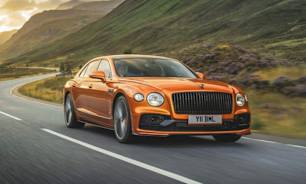The EQS is enormous, so it’s a good thing there’s huge amounts of interior space, even for what is ostensibly an S-Class, and with its bespoke electrified underpinnings, it also scores the kinds of innovations we like to see from electric cars.
These include things like a huge cutaway under the floating dash for extra storage, which the brand has seen fit to add elastic tie-downs so your objects don’t go flying in corners!
Storage up front is otherwise excellent with decent bins in the doors with height-limited sections for bottles, a flip open tray which houses the wireless charger and a set of fold-away bottle holders, and split-opening armrest console box which is deep and features yet another set of USB-C outlets.
Adjustability is great for front passengers, but ergonomically I found something a little weird about the digital dash. For me to rest my arms and hold the wheel, I had to set it so low the top of the wheel obscured the instruments, and if I set it high enough to see the full cluster, to comfortably hold the wheel my elbows would need to float above the armrests. Weird.
It doesn’t end there for the entirely touch-based controls either. While the (admittedly very cool-looking) wheel is packed full of buttons and touch sliders, they require near-surgical precision to operate with your thumbs, distracting while you’re driving, and the enormous centre screen’s main drawback is the fact CarPlay, for example, was not designed for the buttons and functions on the far left to be a metre away from where the driver’s hand is. Again, it’s distracting to have to lean out of your seat to hit the ‘back’ button on most context menus.
I would like to tell you at this point the Mercedes-Benz menus are mercifully simple to aid you with such an overwhelming system, but this isn’t true either. For some reason, there’s a ‘vehicle settings’ menu accessed easily through the main panel, or another menu with a separate set of key functions activated by a car-shaped shortcut button on the floating console. Why? Why aren’t these menus the same? I discovered this in my attempts to use the ‘raise vehicle’ function when faced with a steep driveway. You’re going to need to use this function often in a car measuring over 5.2 metres long, so hiding it in a confusing menu is an interesting choice.
The back seat is where the EQS should shine, and in terms of space it’s stellar. I can barely touch the seat in front of me when set to my own (182cm tall) driving position. It comes with some soft pillows which attach to the headrests, the sunroof extends back there nicely while not impeding on the great headroom, and the lavish trims all continue into the doors and seat bases, too.
The drop-down armrest has a trick pop-out bottle holder in it, and there are a further two on the doors. Amenity-wise rear passengers score four adjustable air vents with two climate zones adjusted via their own touch-panel, but I was interested to see there was a lack of screens back there.
This is particularly notable as most S-Classes are bought to be driven in rather than to drive, and the screens are so much in the front, I was expecting a matching offering for rear travellers. Not so.
You also can’t adjust the rear seats at all, and unlike some EVs coming out in this space, there’s no recliner mode for the full business-class experience.
The boot is much larger than in the smaller EQE, with the EQS making use of its extended dimensions nicely. The floor is fully flat, and has a secret compartment underneath for the storage of both your included Type 2 to Type 2 public AC charging cable, and Type 2 to wall-socket converter for garage charging.
With a total space of 580 litres, the EQS comfortably consumed our entire CarsGuide luggage set with space to spare.







